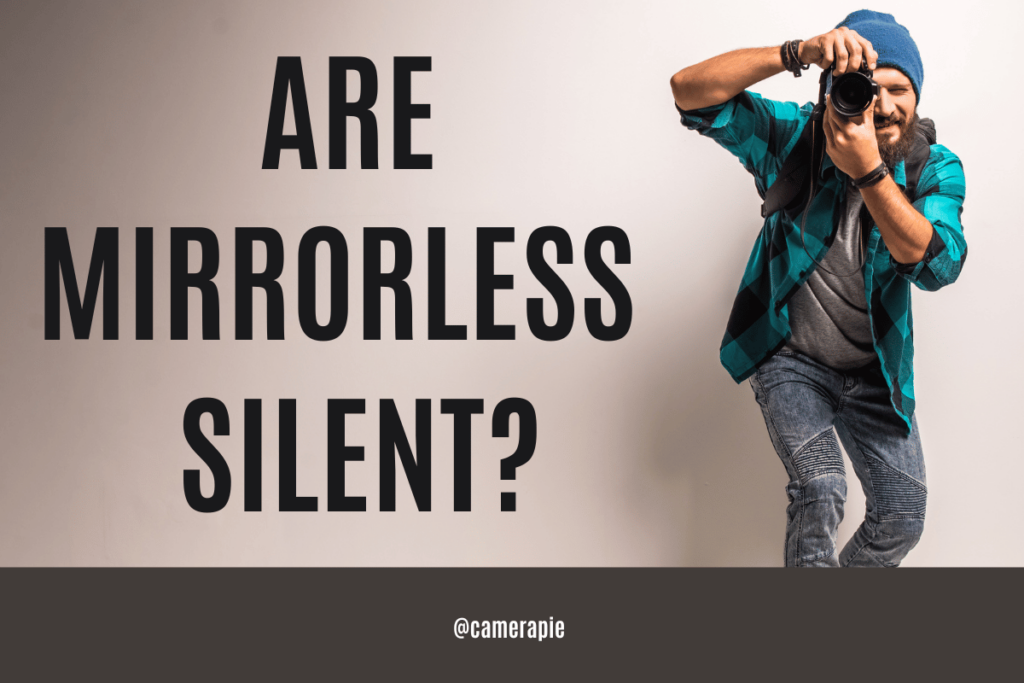
Ever wondered if you can snap a photo without that telltale click? It’s a common question among photographers: Are mirrorless cameras silent when taking pictures? Well, it’s not a simple yes or no answer. It depends on the camera model, settings, and even the shooting environment you’re in.
What Makes a Camera Shutter Sound – Shutter Types
When you’re out capturing life’s moments, sometimes the whisper of a shutter can make all the difference. You may wonder, are mirrorless cameras silent? Let’s dive into the heart of your camera – the shutter.
Mechanical Shutters: The Classic Click
Imagine if every photo you took was punctuated with a sound reminiscent of an old typewriter. That’s the mechanical shutter for you. A staple in DSLRs, and present in some mirrorless models, this type’s hallmark is the physical movement of the shutter curtains to let light hit the sensor. As you press the button, these curtains slide open and closed, producing that iconic click.
Pros:
- Mechanical shutters allow lightning-fast speeds, freezing action with precision.
- They stand the test of time, having been the go-to choice for generations of photographers.
Cons:
- Despite their charm, they can be noisy, especially in quiet environments.
- With moving parts come wear and tear, and eventually, durability concerns.
Electronic Shutters: The Sound of Silence?
On the flip side, the electronic shutter is like the stealth agent of the camera world. It’s your go-to when you need to be a photographic ninja. By electronically activating and deactivating the camera sensor, it’s able to capture an image in near-silence. Mirrorless cameras often boast this feature, allowing the snapping of photos without a peep.
Pros:
- They’re as quiet as a silent film, favoring discretion over tradition.
- Without mechanical parts in motion, they can last longer without wear-related issues.
Cons:
- Speed can sometimes take a hit, causing a lag that might cost you a golden shot.
- They may introduce distortion in fast-moving scenes, known as the rolling shutter effect.
At the Heart of the Sound
Understanding that shutter sound is not just about type, but also settings is vital. Adjustments like a slower shutter speed, a wider aperture, or higher ISO can each influence the decibels your camera will emit. It’s a harmony of mechanics and electronics, working to give you the best shot with the least interruption.
How to Make a Mirrorless Camera Silent?
Mirrorless cameras have gained popularity for their compact size and quieter operation compared to their DSLR counterparts. You might think, “are mirrorless cameras silent?” While they’re not completely silent, due to noises from autofocus systems, image stabilization, and sometimes even cooling fans, there’s a lot you can do to reduce the sound they make.
Reduce Shutter Sound Options
Enabling Silent Mode: Dive into your camera’s menu to find the silent shooting mode. This setting typically employs an electronic shutter to eliminate the sound completely. But remember, using the electronic shutter may introduce rolling shutter effects, particularly when photographing fast-moving objects.
Manual Focus: Autofocus motors can be noisy, so switch to manual focus when you require absolute silence. It might take some practice to get used to manual focusing, but it’s a surefire way to cut down on noise.
Turning Off Image Stabilization: Though it’s a handy feature, image stabilization can add to the sound your camera makes. If you’re shooting on a tripod or in well-lit conditions where slower shutter speeds aren’t needed, consider turning this feature off.
Pros and Cons
As with anything, there are trade-offs. Here are a few you should keep in mind:
- Image Quality: Electronic shutters can affect image quality with certain lighting conditions and don’t always play nice with flash photography.
- Battery Life: Silent mode often consumes more power, meaning you’ll be reaching for the charger more frequently.
- Functionality: Some cameras limit certain features while in silent mode, such as flash use or burst rates.
Silent Shoot Settings Tutorial
Want to mute your camera? Here’s a quick rundown:
- Open the camera menu and navigate to the sound settings.
- Select the ‘Silent Mode’ or ‘Electronic Shutter’ option.
- Confirm the change and exit the menu.
Voila, you’re ready to shoot quietly—or as close to mouse-like as your camera allows.
Optimizing Silent Shooting Settings
To optimize your settings while in silent mode:
- Dial in your exposure manually. Auto-exposure controls can make minute adjustments that cause minor sounds.
- Choose a focal point and use manual focus to lock it in without any autofocus noise.
Perks and Drawbacks of Silent Shooting
When you first turn to mirrorless, the quietness can be uncanny. In your quest to understand are mirrorless cameras silent, you’ve likely unearthed a plethora of benefits, from the stealth needed in wildlife photography to the discretion in solemn settings like weddings or in the streets where the clack of a shutter can break the spell of the moment.
Stealth is your new ally; imagine photographing a timid deer without startling it. Now picture the freedom of capturing a ceremony without drawing eyes toward you instead of the event unfolding. You’re not just a photographer—you’re now a ninja with a lens.
Artistically, silent shooting fosters creativity. With no sound to tether you, you’re more likely to take risks, frame shots from novel angles, and essentially experiment without a second thought.
However, shooting in silence isn’t without its flaws.
Drawbacks of Silent Shooting
You might find yourself at odds with the lack of feedback. That satisfying click you’re so accustomed to? Gone. It can feel like working in a vacuum, unsure if the shot was taken or if your timing was spot on.
The sun can also become a frenemy with silent mode contributing to banding, a distortion appearing in photos with artificial light sources, especially under fluorescent lights where silent mode can clash with the frequency of these lighting conditions.
And let’s not forget the warmth of your camera—literally. Shooting silently puts your little buddy under pressure, leading to overheating. Excessive heat can worsen performance, and, in extreme cases, lead to shutting down to cool off. Not ideal when you’re in the midst of capturing those once-in-a-lifetime shots.
Balancing the Perks and Drawbacks
Finding equilibrium between the pros and cons is key. Use this guide to maintain that delicate balance:
- Sound indicators: If you’re missing auditory cues, enable a beep or click in the software settings. It’s not the shutter’s click, but it’s something to signal a successful capture without drawing too much attention.
- Adjusting the shutter speed: This can help mitigate banding by syncing up with the lighting’s frequency. It’s a bit of science mixed with artistry—just how you like it.
Brand-Specific Shutter Sounds and Features
When you’re on the hunt for the perfect shot, the last thing you want is the click of your camera startling your subject. In the realm of mirrorless cameras, different brands offer varied shutter experiences, some quieter than others.
Nikon’s Whisper
Nikon mirrorless cameras have been lauded for their comparatively soft shutter sound. It’s a bit like the murmur of a distant conversation, not enough to cause a stir. Users have options to adjust the sound, but even on the standard setting, it’s unobtrusive. The Nikon Z series, for instance, ups the stealth with a nearly silent mode that’s a godsend for wildlife photographers.
Olympus: The Discreet Chirp
Olympus cameras are known for their compact size and equally compact sound signature. The brand offers a “Silent Mode” where the shutter sound is just a discreet chirp, easily drowned out by ambient noise. If you’re capturing skittish critters or snapping photos in a hushed gallery, Olympus’s silent features could be your silent partner in crime.
Panasonic’s Hush
Panasonic takes pride in their noise reduction, offering settings that take the decibel level down a notch. Their Lumix series, for example, boasts a sound so hushed it blends into the background. Perfect for street photography, Panasonic lets you become part of the scenery rather than the center of attention.
Hearing Is Believing
Sure, we can talk about how silent these cameras can be, but hearing is believing, right? It’s one thing to read about the gentle click of a Nikon or the faint shutter of a Panasonic, but another entirely to hear it for yourself. A quick search online could lead you to video or audio clips demonstrating these sounds. You’ll find them ranging from the audible yet discreet to the virtually inaudible.
Personalize Your Experience
Your camera’s shutter noise isn’t just about stealth; it’s also about your comfort and control over your photography process. Play with the settings, adjust the volume, and maybe even the tone to match your preference. Don’t let the default settings limit your creative possibilities. After all, your camera is an extension of your artistry.
Frequently Asked Questions
What are the perks of using silent shooting mode in mirrorless cameras?
Silent shooting mode allows photographers to capture images without drawing attention or disturbing the scene, which is useful in sensitive environments like wildlife photography or quiet events.
What are some drawbacks of silent shooting mode?
One potential drawback is that without an audible shutter cue, photographers might miss the tactile feedback of a traditional shutter, which could impact timing for action shots.
How does Nikon’s shutter sound compare to others?
Nikon’s mirrorless cameras, particularly the Nikon Z series, are known for their soft shutter sound, providing a quieter operation compared to many other camera brands.
Does Olympus have a unique shutter sound?
Yes, Olympus cameras are recognized for their discreet “chirp,” which is quiter than traditional shutter sounds but still audible to the photographer.
Can you personalize the shutter noise on mirrorless cameras?
While not all mirrorless cameras offer customizable shutter sounds, many allow users to personalize settings to some extent, catering to the photographer’s preference and creative requirements.
Is it important to experience the shutter sound before purchasing a camera?
Absolutely, since the auditory experience can be subjective, it’s advisable for photographers to listen to the camera’s shutter sound themselves to ensure it meets their expectations and suits their shooting style.

